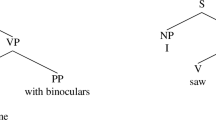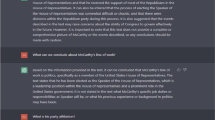Abstract
We survey a sequence of results relating model-theoretic and language-theoreticdefinability over an infinite hierarchy of multi-dimensional tree-like structures and explore their applications to a corresponding range of theoriesof syntax. We discuss, in particular, results for Government and Binding Theory(GB), Tree-Adjoining Grammar (TAG) and Generalized Phrase-Structure Grammar(GPSG) along with a generalized version of TAG extending TAG in much the sameway that GPSG extends CFLs. In addition, we look at a hierarchy oflanguage classes, Weir's version of the Control Language Hierarchy, which ischaracterized by definability in our hierarchy and speculate on possiblelinguistic significance of higher levels of these hierarchies.
Similar content being viewed by others
References
Becker T. (1994) Patterns in Metarules. Proceedings of the 3rd TAG+ Workshop, Paris.
Berwick R. C., Weinberg A. S. (1984) The Grammatical Basis of Linguistic Performance. MIT Press.
Büchi J. R. (1960) Weak Second-order Arithmetic and Finite Automata. Zeitschrift für mathematische Logik und Grundlagen der Mathematik, 6, pp. 66–92.
Candito M-H. (1996) A Principle-based Hierarchical Representation of LTAGs. Proceedings of COLING-96, Copenhagen.
Chomsky N., Schüzenberger M. P. (1963) The Algebraic Theory of Context-free Languages. In Braffort P., Hirschberg D. (eds.), Computer Programming and Formal Systems, Studies in Logic and the Foundations of Mathematics, North-Holland, Amsterdam, 2nd (1967) edition, pp. 118–161.
Chomsky N. (1981) Lectures on Government and Binding. Foris Publications, Cinnaminson, NJ.
Chomsky N. (1986) Barriers. MIT Press.
Chomsky N. (1993) A Minimalist Program for Linguistic theory. In The View from Building 20, MIT Press, pp. 1–52.
Doner J. (1970) Tree Acceptors and Some of Their Applications. Journal of Computer and System Sciences, 4, pp. 406–451.
Elgot C. C. (1961) Decision Problems of Finite Automata Design and Related Arithmetics. Transactions of the American Mathematical Society, 98, pp. 21–51.
Evans R., Gazdar G., Weir D. (1995) Encoding Lexicalized Tree Adjoining grammars with a Nonmonotonic Inheritance Hierarchy. Proceedings of the 33rd Annual Meeting of the Association for Computational Linguisitics (ACL'95), Cambridge, MA.
Fong S. (1991) Computational Properties of Principle-Based Grammatical Theories. PhD thesis, MIT.
Gazdar G., Klein E., Pullum G., Sag I. (1985) Generalized Phrase Structure Grammar. Harvard University Press.
Gécseg F., Steinby M. (1984) Tree Automata. Akadémiai Kiadó, Budapest.
Gorn S. (1962) Processors for Infinite Codes of Shannon-Fano Type. Symp. Math. Theory of Automata.
Gorn S. (1967) Explicit Definitions and Linguistic Dominoes. In Hart J. F., Takasu S. (eds.), Systems and Computer Science, Proceedings of the Conference held at University of Western Ontario, 1965, University of Toronto Press.
Huybregts R. (1984) The Weak Inadequacy of Context-free Phrase Structure Grammars. In de Haan G. J., Trommelen M., Zonneveld W. (eds.), Van Periferie Naar Kern, Foris Publications, Dordrecht, pp. 81–99.
Johnson M. (1989) The Use of Knowledge of Language. Journal of Psycholinguistic Research, 18/1, pp. 105–128.
Joshi A. K. (1985) How Much Context-sensitivity is Required to Provide Reasonable Structural Descriptions: Tree Adjoining Grammars. In Dowty D., Karttunen L., Zwicky A. (eds.), Natural Language Processing: Psycholinguistic, Computational and Theoretical Perspectives, Cambridge University Press.
Joshi A. K., Schabes Y. (1991) Fixed and Flexible Phrase Structure: Coordination in Tree Adjoining Grammars. Presented at the DARPA Workshop on Spoken Language Systems, Feb. 1991, Asilomar, CA.
Joshi A. K., Schabes Y. (1992) Tree-adjoining Grammars and Lexicalized Grammars. In Nivat M., Podelski A. (eds.), Tree Automata and Languages, Elsevier Science Publishers B.V., pp. 409–431.
Khabbaz N. A. (1974) A Geometric Hierarchy of Languages. jcss, 8, pp. 142–157.
Langendoen D. T. (1976) On the Weak Generative Capacity of Infinite Grammars. CUNYForum, 1, pp. 13–24.
Lewis H. R. (1979) Unsolvable Classes of Quantificational Formulas. Addison-Wesley.
Manzini M. R. (1992) Locality: A Theory and Some of Its Empirical Consequences. MIT Press, Cambridge, MA.
Palis M. A., Shende S. M. (1995) Pumping Lemmas for the Control Language Hierarchy. Mathematical Systems Theory, 28, pp. 199–213.
Rabin M. O. (1969) Decidability of Second-order Theories and Automata on Infinite Trees. Transactions of the American Mathematical Society, 141, pp. 1–35, July 1969.
Rizzi L. (1990) Relativized Minimality. MIT Press.
Rogers J. (2001) Weak MSO Theories and Control Languages. In preperation.
Rogers J. (1996) What Does a Grammar Formalism Say about a Language. Technical Report IRCS-96-10, Institute for Research in Cognitive Science, University of Pennsylvania, Philadelphia, PA.
Rogers J. (1997a) “Grammarless” Phrase Structure Grammar. Linguistics and Philosophy, 20, pp. 721–746.
Rogers J. (1997b) A Unified Notion of Derived and Derivation Structures in TAG. Proceedings of the Fifth Meeting on Mathematics of Language MOL5 '97, Saarbrücken, FRG.
Rogers J. (1998a) A Descriptive Approach to Language-Theoretic Complexity. Studies in Logic, Language, and Information, CSLI/FoLLI.
Rogers J. (1998b) A Descriptive Characterization of Tree-Adjoining Languages. Proc. of the 17th International Conference on Computational Linguistics (COLING'98) and the 36th Annual Meeting of the Association for Computational Linguistics (ACL'98), ACL, Montreal.
Rogers J. (1998c) On Defining TALs with Logical Constraints. In Abeillé A., Becker T., Rambow O., Satta G., Vijay-Shanker K. (eds.), Fourth International Workshop on Tree Adjoining Grammars and Related Frameworks (TAG+4), pp. 151–154.
Rogers J. (1999) Generalized Tree-adjoining Grammar. Sixth Meeting on Mathematics of Language, pp. 189–202.
Rogers J. (2000) wMSO Theories as Grammar Formalisms. Algebraic Methods in Language Processing, Proceedings of the Second AMAST Workshop on Language Processing, TWLT 16, Iowa City, IA, Universiteit Twente, pp. 201–222.
Rounds W. C. (1970) Mappings and Grammars on Trees. Mathematical Systems Theory, 4, pp. 257–287.
Sarkar A., Joshi A. (1996) Coordination in TAG: Formalization and Implementation. Proceedings of COLING'96, Copenhagen.
Schabes Y., Shieber S. M. (1994) An Alternative Conception of Tree-adjoining Derivation. Computational Linguistics, 20/1, pp. 91–124.
Shieber S. M. (1985) Evidence Against the Context-freeness of Natural Language. Linguistics and Philosophy, 8, pp. 333–343.
Smets M. (1998) Comparison of XTAG and LEXSYS Grammars. In Abeillé A., Becker T., Rambow O., Satta G., Vijay-Shanker K. (eds.), Fourth International Workshop on Tree Adjoining Grammars and Related Frameworks (TAG+4), pp. 159–163.
Thatcher J. W. (1967) Characterizing Derivation Trees of Context-free Grammars Through a Generalization of Finite Automata Theory. Journal of Computer and System Sciences, 1, pp. 317–322.
Thatcher J. W., Wright J. B. (1968) Generalized Finite Automata Theory with an Application to a Decision Problem of Second-order Logic. Mathematical Systems Theory, 2/1, pp. 57–81.
Vijay-Shanker K., Schabes Y. (1992) Structure Sharing in Lexicalized Tree-adjoining Grammars. Proceedings COLING'92.
Weir D. J. (1988) Characterizing Mildly Context-Sensitive Grammar Formalisms. PhD thesis, University of Pennsylvania.
Weir D. J. (1992) A Geometric Hierarchy Beyond Context-Free Languages. Theoretical Computer Science, 104, pp. 235–261.
Xia F., Palmer M., Vijay-Shanker K., Rosenzweig J. (1998) Consistent Grammar Development Using Partial-Tree Descriptions for Lexicalized Tree-adjoining Grammars. In Abeillé A., Becker T., Rambow O., Satta G., Vijay-Shanker K. (eds.), Fourth International Workshop on Tree Adjoining Grammars and Related Frameworks (TAG+4), pp. 180–183.
XTAG Research Group (1998) A Lexicalized Tree Adjoining Grammar for English. Technical Report IRCS-98-18, Institute for Research in Cognitive Science.
Author information
Authors and Affiliations
About this article
Cite this article
Rogers, J. Syntactic Structures as Multi-dimensional Trees. Research on Language and Computation 1, 265–305 (2003). https://doi.org/10.1023/A:1024695608419
Issue Date:
DOI: https://doi.org/10.1023/A:1024695608419




